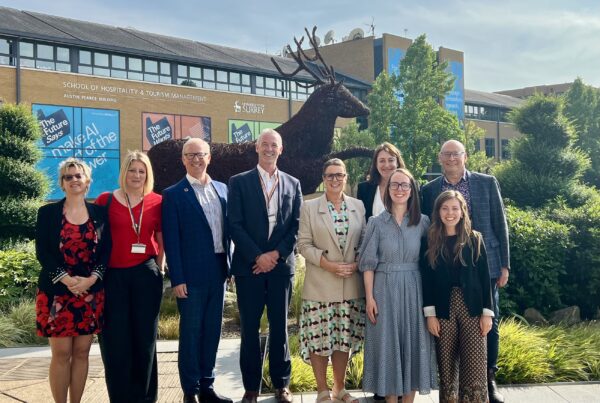Wayne Gretzky, the famous Canadian ice hockey player, is quoted as saying that he “skates to where the puck is going to be, not where it has been”. He argues his success against competitors was down to that. Is competition among universities and their leaders similarly coming down to who can foresee the future better than others, and get there faster?
There are many qualities required of all leaders in business and academic life. The ability to lead people, develop culture and form partnerships are clearly coming to the fore among them. A significant part of academic and university leadership has until now been focused on having credibility and the respect of fellow academics, donors, alumni and university partners.
This focus has been of greatest importance in a stable world where tradition and reputation have been prioritised over innovation and change. Is that still the situation now?
Many would argue that in the world of business, the need for innovation is ever-present and speeding up. We would argue that in the world of global higher education, innovation and leading transformational change is becoming more important. It needs to be a greater priority for leaders.
One of the classic ways of guiding and planning for innovation has been to forecast the future operating environment, markets and technological drivers in a sector. Scenario planning emerged as a technique to facilitate this.
By outlining alternative dominant characteristics of themes of the future, leaders and their management teams can be stimulated to plan strategy and innovation of how best to be in the right position for an anticipated future. It is a way to prepare for the future they believe to be most likely, and how they want to engage with it.
A report by HolonIQ from 2018 painted a picture of five themes for the future of Higher Education that were anticipated for 2030. The scenarios were developed by a combined process of top-down views arising from data and bottom-up views arising from consultation with sector stakeholders.
The five scenarios are:
- Education-as-usual: where traditional education institutions remain the trusted source of learning and the most effective vehicle for jobs and prosperity. Higher education consolidates, global talent platforms emerge and government remains the core source of funding.
- Regional rising: where regional alliances dominate the competitive education landscape, supported by strategic and political cooperation. Cooperative blended delivery and regional talent hubs cross-load labour supply and demand to strengthen regions.
- Global giants: A free market environment fosters the emergence of “mega-organisations” with ubiquitous brand recognition and the scale to achieve significant efficiencies and industry power.
- Peer to peer: Learning online through rich, personalised human to human experiences dominates the post-secondary and skills training sectors. Blockchain technology fundamentally reconfigures credentialling and unlocks the collective creativity and IP of teachers.
- Robo revolution: AI drives a complete reversal in “who leads learning” with virtual tutors and mentors structuring learning paths, providing assessment tasks, giving feedback, adjusting according to progress and organising human tutoring when needed.
Since that HolonIQ report was prepared, major global changes include a pandemic, and the associated changes in learning and research priorities and customs and practices. They have changed the emphasis in some of these scenarios. They have accelerated the rate at which some of them are now forecast to occur.
This shows the clear imperative to not only focus on where the market may be going, but continuously re-appraise what future expectations are. They also show the importance of the speed with which you are travelling toward the future compared with competitors.
Just about every global university has had significant projects focused on future learning practices over the last five years. Progressing them fast enough, and ensuring they become embedded in mainstream organisational strategies and practices, is more challenging.
Moves online as a result of lockdowns and pandemic operations may have invoked more mainstream digital business continuity operations for a while. But are these enduring and sufficiently fast and far enough relocations to align with a future scenario your university now believes it is moving towards? If so by when, and how much quicker than everyone else does it need to get there? And how will it make that happen?
There is a compelling need for collaboration and partnership between universities and others in both forecasting the future and preparing for it. This is increasingly needing to be with EdTech providers and other service providers that help facilitate transformation and change drawing on experiences from other sectors.
What the HolonIQ reports and services demonstrate is the importance of data and market intelligence in knowing where the higher education puck may be travelling to and how quickly. We also need to know what others are also doing to get there, and who they are.
There are examples from other parts of the world where individual innovative universities, groups of universities, partnership models and private providers of various forms are moving quickly to innovate their business models, something that Australian universities may also need to consider more closely.
This has not been an issue for most up until now with stable demand for traditional on-campus domestic and international students, however, emerging data from the US shows reductions in demand, and increases in college and university mergers and closures. It suggests a move away from business as usual might be needed with greater urgency. Is this scenario becoming global?
The emergence of strong eco-systems around single institutions, and more broadly to facilitate innovation and change by the best survivors, might give pointers to what we increasingly need in Australia.
That could be the facilitation of faster progress towards a clearer picture of a preferred future state informed by data, market intelligence and exemplars and cases of leading global practice. Afterall, who gets to decide where the puck is moving to?
First published in Campus Review on 17th August 2022
Emeritus Professor Martin Betts, Co-Founder of HEDx
Maria Spies, co-CEO and co-founder of HolonIQ.









